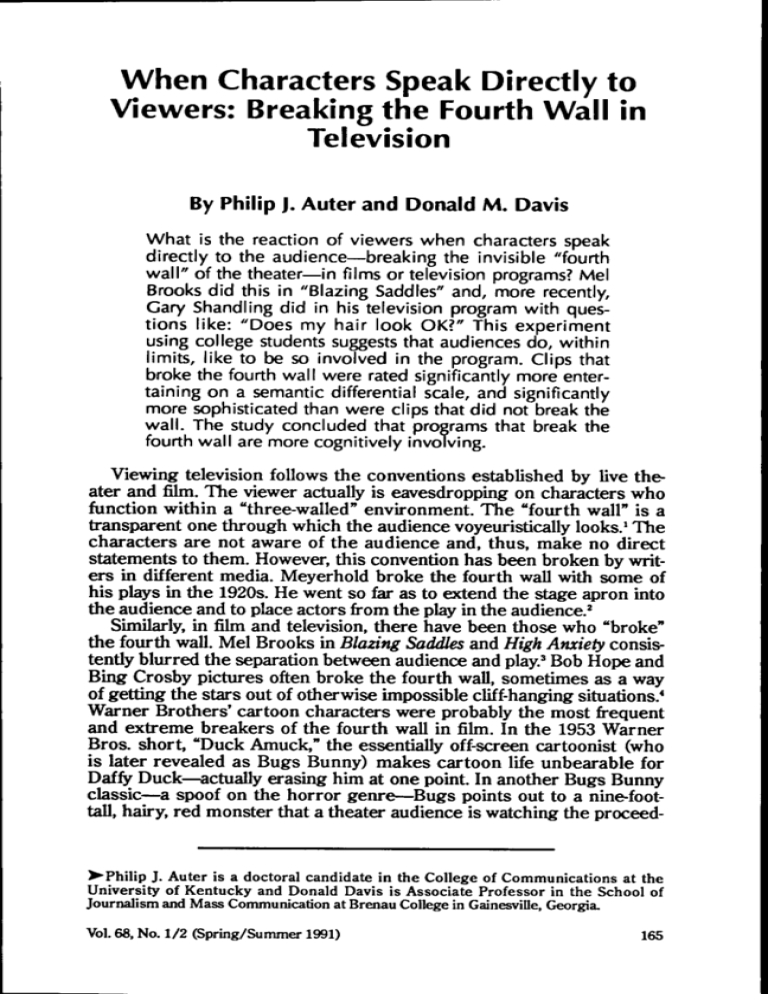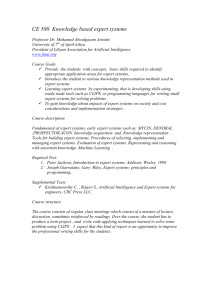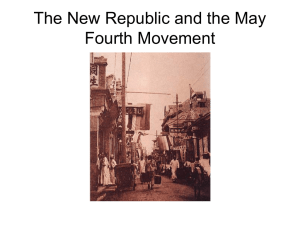When Characters Speak Directly to Viewers: Breaking the Fourth
advertisement

When Characters Speak Directly to Viewers: Breaking the Fourth Wall in Television By Philip J. Auter and Donald M. Davis what is the reaction of viewers when characters speak directly to the audience—breaking the invisible "fourth wall" of the theater—in films or television programs? Mel Brooks did this in "Blazing Saddles" and, more recently, Gary Shandling did in his television program with questions like: "Does my hair look OK?" This experiment using college students suggests that audiences do, within limits, like to be so involved in the program. Clips that broke the fourth wall were rated significantly more entertaining on a semantic differential scale, and significantly more sophisticated than were clips that did not break the wall. The study concluded that programs that break the fourth wall are more cognitively involving. Viewing television follows the conventions established by live theater and film. The viewer actually is eavesdropping on characters who function within a "three-walled" environment. The "fourth wall" is a transparent one through which the audience voyeuristically looks.' The characters are not aware of the audience and, thus, make no direct statements to them. However, this convention has been broken by writers in different media. Meyerhold broke the fourth wall with some of his plays in the 1920s. He went so far as to extend the stage apron into the audience and to place actors from the play in the audience.^ Similarly, in film and television, there have been those who "broke" the fourth wall. Mel Brooks in Blazing Saddles and High Anxiety consistently blurred the separation between audience and play.' Bob Hope and Bing Crosby pictures often broke the fourth wall, sometimes as a way of getting the stars out of otherwise impossible clijff-hanging situations.' Warner Brothers' cartoon characters were probably the most frequent and extreme breakers of the fourth wall in film. In the 1953 Warner Bros, short, "Duck Amuck," the essentially off-screen cartoonist (who is later revealed as Bugs Bunny) makes cartoon life unbearable for Daffy Duck—actually erasing him at one point. In another Bugs Bunny classic—a spoof on the horror genre—Bugs points out to a nine-foottall, hairy, red monster that a theater audience is watching the proceed- >• Philip J. Auter is a doctoral candidate in the College of Communications at the University of Kentucky and Donald Davis is Associate Professor in the School of Journalism and Mass Communication at Brenau College in Gainesville, Georgia. Vol. 68, No. 1/2 (Spring/Summer 1991) 165 166 JOURNALISM QUARTERLY ings. The fourth wall broken, the monster screams, "People!" and runs away.' In television of the 1950s, George Burns made a habit of chatting with viewers during the action in his situation comedy. On the Dobie Gillis Show, Dobie talked to viewers during intro and postscript segments. The Monkees, like Hope and Crosby infilm,tended to use fourth wall breaking as a way of getting the characters out of sticky situations.' It's Gary Shandling's Show seemed almost preoccupied with breaking down the wall.' Moonlighting, until its cancellation in early 1989, was the only action program (albeit comedic action) to break the fourth wall.' Some shows are more direct than others. In Gilligan's Island, for example, the skipper occasionally stares exasperatedly at the viewer after Gilligan has done something particularly ridiculous. He doesn't speak; he merely acknowledges the audience's existence with a glance that seems to say "see what I have to put up with?"—much as Oliver Hardy did 40 years earlier.' At the other extreme is Gary Shandling who interrupts the show to walk to the studio audience (shown on camera) and ask "Does my hair look OK?" He also uses the direct conversation device to move the story along (without the usual narrative) when he turns to the audience and says "It's twenty minutes later now and Grant is coming to my apartment." In this study, we were interested in assessing the reaction of viewers to the practice of breaking the fourth wall. Do they feel more involved in the program? Do they enjoy the breaking of the wall? We employed the interest-involvement approach to our analysis because it places the locus of involvement in the viewer/program interaction more on the Involvement Involvement has been operationalized and conceptualized in a number of differing, and sometimes, conflicting, ways. Sahnon noted the definitional problem, but pointed out that there is general agreement in the area of interest-involvement. Interest-involvement keys in on the person's cognitive and behavioral reactions to a stimulus. Here, involvement is defined by the level of cognitive processing a person performs and/or how much a person participates in a given activity." A number of authors have operationalized involvement as related pri1 . 0 . Brockett, Tht Tlualn.An MmdudiM (New York: Holt, Rinehart, and Winston, 1969). 2. E. Wason. and A. Gold&rb, Uving Vwatn (New Yoric McGraw-Hill, 1983). 3.NickSmtirthwaiteandPaiilGdder,JV(/£nK>ibaiu(tt( J^^mt^Movw, (New Yoric: Proteus Books, 1982). 4. Bob Hope and Bob Thomas, Vu Road to HoUymod: My Forty- Ytar Unt Affair Wilk tkt Movrn (Garden City, New York: Doubleday & Company, Inc., 1977). 5. Chuck Jone8, Ckuck Amuck: Vu Lift md Tima if an Animattd Cartoonist (New York: Farrar Straus Giroux, 1989). Also, Jerry Beck and Win Friedwald, Looney TUna and Mtrrit Mtlodits: A Complttt Ilhatrattd Cuidt to tht WanirBrm. Cartoons (New York: Henry Holt and Company, 1989). 6. Leslie Raddatz, "More Fun Ihaa-i^ Barrel ofthe Originals,' TVGuidt, 18-21 Oanuary 28,1967). 7. David Gritten, 'Shandling Reaps the Rewards of a Risky Venture,' Chicago Thbunt TV With, M (October 25, 1987). Also, Michael PoUan, T h e Sitcom With Turbopower, 'Channtb, 6061 (April, 1987): and Harry F. Waters. 'Sending Up a TV Ritual: An Anti^atcom Sitcom,' Ntwswtth, 6S«9 (November 3,1986). 8. Harry F. Waters and Nikki Finke Greenberg, 'Sty and Sexy: TV s Fun Couple,' Ntvsmuk, 4&52 (September 8, 1966). Also, Michael Pollan, *Why Moonlighting Shines,' Ckanntts, 74,76 Oanusry/Febniary, 1966). 9. John McCabe, Al Kilgore and Richanl W. Bann, ^iniR< A/Amfr (New York: E. P. Dutton, 1975). 10. C. Salmon, Perspectives on Involvement in Consumer and Communication Research,' in B. Dervin and M. Voigt, eds., Progrtss in Communication Sdtncts, 7243-268 (Reading, MA: Ablex, 1986). IL Salmon, of. cil. 12. T. A. Zimmer, 'Media Exposure to Campaigns: Public Anticipation and Involvement in Elections,' Commtinication Rtstarck, 8:18»'2(M (1981). Also, R. Mulder, T h e EtfectB of Televised PoUtical Ads in the 1975 Chicago Mayoral Election,'yiwnaJtsM Quarttriy, 56:336^0 (1979): J. T. Pedersen, 'PoElical Involvement and Partisan Change in Presidential Elections,' Amtricm Journal <^PoUtical Sdtnct, 2 2 : 1 8 ^ (1978): and G. S. Day, Buytr AttOudts and Brand Otoia (New Yoric: Free Press, 1970). Breaking the Fourth Wall in Television 167 marily to interest." In fact, Salmon noted that many researchers have used the terms interchangeably." In this paradigm, lack of interest—operationalized as apathy—reduces involvement as an inevitable consequence. Heightened interest leads to greater involvement. Participation—which considers the behavioral aspect of audience involvement—has been used by others as the central measure of interest-involvement research." For the purposes of this study, we utilized interest involvement as the primary concept for analysis because it lends itself well to viewers' interaction with television. Our study hoped to discover whether viewers liked the convention of breaking the fourth wall in comedy programming more than more standard comedy fare. Method Some 223 students enrolled in an introduction to mass media course were randomly assigned to one of three groups to view clips from television shows. TTie shows were: Burns and Allen, The Dobie Gillis Show, The Monkees, Moonlighting, and It's Gary Shandling's Show. Three onenunute clips were selected from each show. One clip included a fourth wall break, the other two did not. Minutes were randomly selected from each show from which to draw the clips. Then a coherent segment was chosen with a starting point within that minute. In drawing the break clip, minutes without clips were rejected until one containing a break clip occurred. The 15 clips were randomly assigned to three five<lip groups with the stipulation that each group had to have at least one break clip but no more than two. The order of presentation of the clips to the viewing groups was randomly chosen to reduce order effects.'' After viewing each clip the students were asked to complete a 15item set of seven-point semantic differential items. Several item pairs felt to relate to television were chosen from an original list developed by Osgood. Others such as "Funny/Not Funny" were developed along the same lines and added so that the scale might better measure opinions of television." The list of items consisted of: Funny/Not Funny, Interesting/Boring, Entertaining/Not Entertaining, Intelligent/Not Intelligent, Involving/Uninvolving, Good/Bad, Pleasant/Annoying, Deep/Shallow, Relaxed/Tense, Complex/Simple, Friendly/Unfriendly, Enjoyable/Not Enjoyable, Important/Unimportant, Comfortable/ Uncomfortable and Like/Dislike. The questionnaire also included several media use and demographic questions. Item scores were averaged across programs and across groups in an attempt to reduce order effect. Average item scores were fector analyzed using the Statistical Package for the Social Sciences, version 10." The factor analysis was performed using an oblique rotation and the extraction method of principal axis factoring. The eigenvalue was set at 13. Salmon, d^. cil. 14. A. S. Tta, "Mass Media Use, Issue Knowledge, and Political bivohrement,' Public Opinion QuarUrly, 44241-248 (1960). Also, S. H. Surlin. "Kace. Education, and Fatalism: Fredictore of Involvement in Kadio Programming,'/oiinuil of Broadcasting, 21:413-426 (X9r77). 15L The clips in the^firet group were: Shandling (break), Shandling (non-break), Bums/AUen (break), Monkees Otioivteeak), and Moonlighting (non-break). The second group iiEluded: Dobie (noivbreak), Bums/AUen frioivtreak), Monkees Owivbicak), Moonlighting (break), and Shandling (nonJireak). The third group included: Dofaie (hontreak), Dobie (break), Bums/AIen (honbreak), Monkees (break), and Moonlighting (non-break). 1& Chaiks Oagood, Tkt Mtasurtmtnt o/Mtaning (Urbana, IL University of Illinois Press, 1965). 17. SPSS*, e n d Ed.) (Chicago: SPSS Inc., 1986). 168 JOURNAUSM QUARTERLY 1.00, and delta was set at 0.00. Factor loadings were sorted and coefficients lower in absolute value than .30 were suppressed. Mean scores of emerging factors were compared using the statistical procedure t-test. Because each individual responded to both breaking and non-breaking clips, paired t-tests were used to compare mean Results The factor analysis converged in nine iterations. The two factors that emerged, "entertainment value" and "content sophistication," were only minimally correlated (r = .1936) suggesting that they measured two clearly different dependent variables. The first factor, entertainment value, had a Cronbach's alpha of .9487 and was made up of nine items. The second factor, content sophistication, consisted of four items and had a Cronbach's alpha of .8878 (See Table 1). The two factors explained 67.6% of the variaice. One double loading above .30 occurred on the item Involving/Uninvolving. A negative loading appeared on Relaxed/Tense. Both items were dropped from the analysis. Table 1 Rotated Factor Pattern Matrix^ Loading Variable Enjoyable/Not Enjoyable Entertaining/Not Entertaining Pleasant/Annoying Good/Bad LQce/Dislike Funny/Not Funny Interesting/Boring Comfortable/Uncomfortable Friendly/Unfriendly Deep/Shallow Complex/Siinple Important/Unimportant Intelligent/Unintelligent Entertainment Value Content Sophistication .8807 .8551 .8207 .8186 .8072 .7723 .7663 .7595 .6786 .8854 .8299 .7812 .6840 1 Involving/Uninvolving double loaded and was ttierefore dropped. Relaxed/Tense loaded negatively and was also dropped. Pearson correlation coefficients were calculated to determine interitem relationships for each factor. In Factor 1, "entertainment value," most items were highly correlated, suggesting that the items measure essentially the same factor (See Table 2). Friendly/Unfriendly and Comfortable/Uncomfortable were only slightly correlated with other items however. In Factor 2, "content sophistication," nearly all the items were highly correlated suggesting that they measure essentially the same factor (See Table 3). Intelligent/Unintelligent and Complex/ Simple were only somewhat inter-correlated, however (r = .5552, p = .0001). Paired t-tests were run to compare factor means across breaking and Breaking the Fourth Wall in Television 169 non-breaking clips.For the first factor, entertainment value, scores were significantly higher for breaking clips (M = 4.9088, SD = 1.094) than non-brealdng clips (M = 4.7324, SD = .685), t(222) = 2.34, p = .02. Table 2 Pearson correlation coefficients for Factor 1^ Enjoyable Entertaining Pleasant Good Like Enjoyable Entertaining 1.0000 .8540 1.0000 Pleasant .8288 .7396 1.0000 Good .8146 .8017 .7049 1.0000 Funny Interesting Comfortable Enjoyable Entertaining Pleasant Good Like Funny Interesting Comfortable Friendly .7603 .8246 .6431 .8137 .7958 1.0000 .7508 .8328 .6292 .8088 .7791 .8115 1.0000 Like .8515 .8069 .7357 .8419 1.0000 Friendly .5389 .5009 .5673 .5393 .5434 .4853 .4930 1.0000 .4985 .4513 .4434 .5430 .4520 .4582 .4360 .6920 1.0000 *For all correlations N - 223, p < .(X)05 Table 3 Pearson correladon coefficients for Factor 2« Deep Complex Important Intelligent Deep 1.0000 Complex .7622 1.0000 Important .7283 .6083 1.0000 Intelligent .6959 .5552 .6713 1.0000 ^ For all correlations N - 223, p < .0005 But if respondents seemed to be more entertained by breaking clips they also appeared to find them more sophisticated. For factor two, scores for breaking clips (M = 3.7410, SD = 1.076) were much higher than for non-breaking clips (M = 3.1163, SD = .830), t(222) = 7.78, p< .001. Discussion The pattern of significance in the results is surprisingly consistent. While some shows were more contemporary, like Moonlighting and Gary Shandling, and some were very old, like Dobie Gillis and Burns and Allen, the results were the same. There was no significant deviation within shows or between eras. The highest mean score for a break clip was actually scored by the Burns and Allen Show which had its run before most of the respondents were born. What the study seems to point to is a generalized liking for the practice of breaking the fourth wall. To some extent this has been ascertained by programmers who use the practice with increasing frequency. But the liidng for the practice may be even deeper than programmers 170 JOURNALISM QUARTERLY suspect. The two factors developed in the study varied widely in what they measured—entertainment value and content sophistication. And yet scores were extremely positive in both cases. It must be noted, however, that the respondent group was made up of young college students—most were between 18 and 22 years-of-age. That means that the study is more a measure of one age group and education level than a measure of generalized attitudes. like the majority of Americans their age, however, the respondents were certainly weaned on television and its various formats. It is certainly plausible that the respondents, and in fact most younger TV viewo-s, could be considered amateur critics, capable of analyzing and working within various TV formats even if they are incapable of expressing how they do it. In this case, the respondents seemed to like "being in on the joke" of television. They enjoyed the break witii television's conventions. It would be well, however, to repeat the same procedures with groups representing a wider range of ages and education levels. Participation is a primary determiner of interest-involvement, and the shows studied invite their viewers to participate in tiie content by speaking directly to them—^with surprising results. That interactive relationship redefines the normally passive relationship with a given show and makes the viewers a part of the action. In interest-involvement the locus of involvement rests primarily on the viewer. Entertainment value and content sophistication appear to be two powerful cognitive indexes of viewer interest in programming. Interest-involvement appears to be a fitting theoretical paradigm for the study of audience-message interaction in television. Although the cognitive aspect of interest-involvement was clearly tapped, the behavioral side might have been better served if the study had included a number of post-exposure intended media-use questions. The findings certainly suggest that people like to be included in the context of their media. And when message producers make tiie exti-a effort to acknowledge their audiences' existence, audience members are ready to take part. Further analysis and careful use of such involving techniques as "fourth wall breaking" may help program producers to achieve the goal of getting audience members to attend to the message. It must be noted, however, that several limitations may exist to the effectiveness of breaking the fourth wall as an audience involving technique. First, audiences may well habituate to frequent breaking of the fourth wall within or across programming. Although critically ^plauded. It's Gary Shandling's Show had fallen sharply in the ratings near the end of its run. It's quite possible that audiences became used to the program's format and tired of the show. Also, breaking the fourth wall may be a technique that must be relegated to the less realistic worlds of comedy programming. Because of their inherent aesthetic natures, television and film are limited in their ability to emulate the real world. Our "willing suspension of disbelief—so necessary in dramatic programming to allow us to accept plot and action—^would most certainly be shattered by characters making asides to the viewer. Still, even dramatic programming, for example Magnum P.I., may be able to break the fourth wall successfully, if sparingly, in humorous transition scenes. Breeding the Fourth Wall in Television 171 It appears that audiences do prefer comedy that breaks the fourth wall to comedy that does not. But is it the technique, or die variety from conventional formats that they enjoy? Would they habituate if exposed regularly to such content? When Of at all) is breaking the fourth wall acceptable in dramatic programming? More analysis of this and other content manipulation techniques must be performed in order to better understand the complex audience-program relationship.








